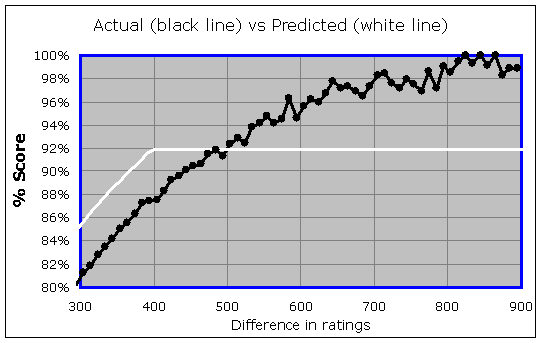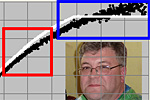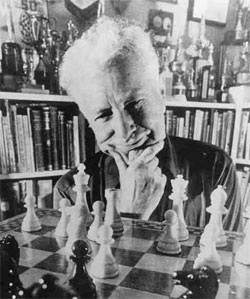says
Looking for a bat that makes me faster
says
Looking for a bat that makes me faster
Active Member
I have done some calculations to help translating ratings v.s. skill levels. My calculations are done based on data from https://www.teamusa.org/USA-Table-Tennis/Ratings/Rating-System
When two players play together, the winner will gain the exact amount of points that the loser will lose. The amount of point exchanged depends on the difference of the ratings. Let X be the point exchanged when the higher-rated player wins and Y be the point exchanged when the lower-rated player wins.
Imagine two players with perfectly accurate ratings play against each other over infinite number of matches. Their ratings should not change in the long run. Now let P be the probability of the higher-rated player to win. We now have
P*X=(1-P)*Y
Rearranging this equation gives
P = Y/(X+Y)
Now we can produce the following graph

Markers are what the USTTA rules specify, the red dotted line is a fit with fixed points (P=0.5 if both players have the same rating, P=1 if the difference in rating is 238).
Some rule-of-thumb from this graph:
- if your opponent's rating is 50 points above yours, you are expected to win ~30% of the time.
- if your opponent's rating is 100 points above yours, you are expected to win ~20% of the time.
- if your opponent's rating is 150 points above yours, you are expected to win ~10% of the time.
I hope this makes it easier to understand the differences in level and the ratings. Let me know if there's any mistake
EDIT: Thanks to @brokenball, I have now realised that the fitted equation is only applicable if the difference in rating (x) is between 0 and 238. Let f(x) be the fitted equation on the graph above,
y = 1 if x >=238
y = f(x) if 238 > x >=0
y = 1-f(-x) if 0 > x >= -238
y = 0 if -238 > x

When two players play together, the winner will gain the exact amount of points that the loser will lose. The amount of point exchanged depends on the difference of the ratings. Let X be the point exchanged when the higher-rated player wins and Y be the point exchanged when the lower-rated player wins.
Imagine two players with perfectly accurate ratings play against each other over infinite number of matches. Their ratings should not change in the long run. Now let P be the probability of the higher-rated player to win. We now have
P*X=(1-P)*Y
Rearranging this equation gives
P = Y/(X+Y)
Now we can produce the following graph
Markers are what the USTTA rules specify, the red dotted line is a fit with fixed points (P=0.5 if both players have the same rating, P=1 if the difference in rating is 238).
Some rule-of-thumb from this graph:
- if your opponent's rating is 50 points above yours, you are expected to win ~30% of the time.
- if your opponent's rating is 100 points above yours, you are expected to win ~20% of the time.
- if your opponent's rating is 150 points above yours, you are expected to win ~10% of the time.
I hope this makes it easier to understand the differences in level and the ratings. Let me know if there's any mistake
EDIT: Thanks to @brokenball, I have now realised that the fitted equation is only applicable if the difference in rating (x) is between 0 and 238. Let f(x) be the fitted equation on the graph above,
y = 1 if x >=238
y = f(x) if 238 > x >=0
y = 1-f(-x) if 0 > x >= -238
y = 0 if -238 > x
Last edited:


















